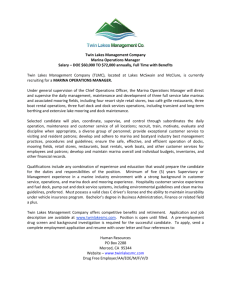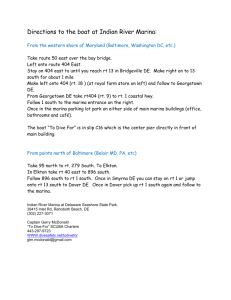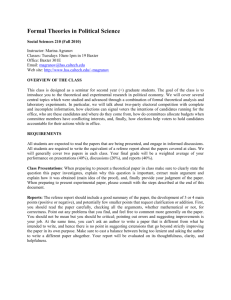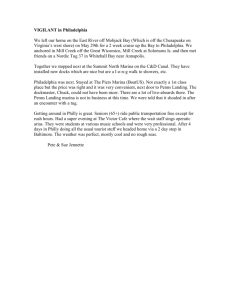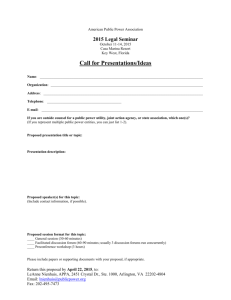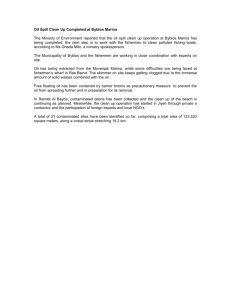PORTRAIT OF A MARINA
advertisement
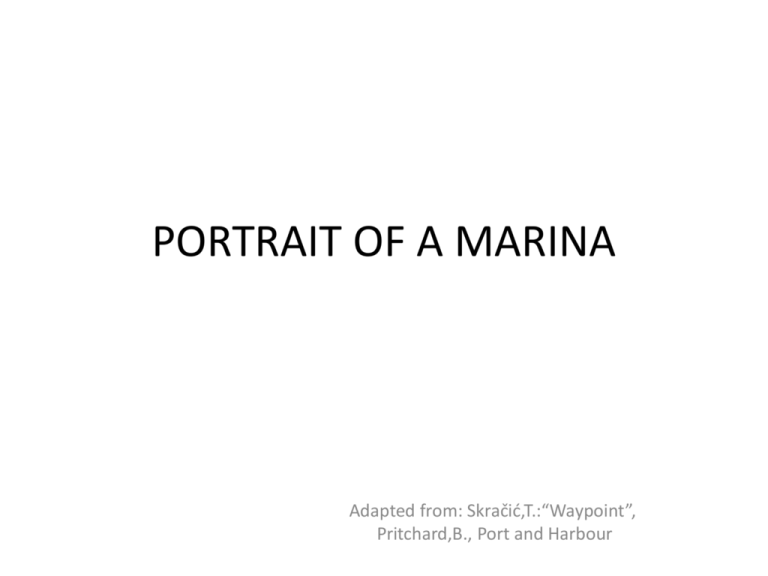
PORTRAIT OF A MARINA Adapted from: Skračić,T.:“Waypoint”, Pritchard,B., Port and Harbour • port, harbour, haven • port structures • wharf • berth • quay • pier • jetty • dock • mole • breakwater • dock basin • terminal • A port is a facility for receiving ships and transferring cargo. They are usually situated at the edge of an ocean, sea, river, or lake. Ports often have cargo-handling equipment. • Harbour pilots and tugboats are often used to maneuver large ships in tight quarters as they approach and leave the docks. Ports which handle international traffic have customs facilities. (Source: Wikipedia) • The terms "port" and "seaport" are used for ports that handle ocean-going vessels, and "river port" is used for facilities that handle river traffic, such as 2 barges and other shallow draft vessels. • Some ports on a lake, river, or canal have access to a sea or ocean, and are sometimes called "inland ports". • A "fishing port” is a type of port or harbor facility particularly suitable for landing and distributing fish. • A "dry port" is a term sometimes used to describe a yard used to place containers or conventional bulk cargo, usually connected to a seaport by rail or road. • A "warm water port" is a port where the water does not freeze in winter. Because they are available year-round, warm water ports can be of great geopolitical or economic interest, with the ports of Saint Petersburg and Valdez being notable examples. • A "port of call" is an intermediate stop, for example to collect supplies or fuel. • Various dictionaries give the following main entries for the word ‘port’: • • a place on a waterway with facilities for loading and unloading ships. • • a city or town on a waterway with such facilities. • • the waterfront district of a city. • • a place along a coast that gives ships and boats protection from storms and rough water; a harbor. • The terms port, harbour and haven are more or less synonymous, but each of them also has specific meanings. • A harbour (US spelling "harbor") is a place of security and comfort, a small bay or other sheltered part of an area of water, usually well protected against high waves and strong currents, and deep enough to provide anchorage for ships and other craft. It is also a place where port facilities are provided, e.g. accommodation for ships and cargo handling facilities. • The term port or seaport normally includes the harbour and the adjacent town or city suitable for loading goods and embarking men. • A haven is a type of harbour used in literature or in names and adds the idea of refuge. • Ships are accommodated and handled, i.e. loaded and unloaded, at such port structures as; wharfs or quays, piers and jetties, and sometimes alongside moles or breakwaters. • Any place where a ship can safely lie alongside a quay, pier or dock, at anchor or a buoy, and where she can carry out loading/discharge operations or embark and disembark passengers is called a berth (vez, pristan). • A dry dock (suhi dok; remontno brodogradilište) is a type of dock consisting of a rectangular basin dug into the shore of a body of water and provided with a removable enclosure wall or gate on the side toward the water, used for major repairs and overhaul of vessels. • When a ship is to be docked, the dry dock is flooded, and the gate removed. • Wharf ((lucka) obala) is the oldest term in English referring to port structures. It denotes any structure of timber, masonry, cement, or other material built along or at an angle to the navigable waterway, with sufficient depth of water to accommodate vessels and receive and discharge cargo or passengers. The term • can be substituted for quay ((lucka) obala) when applied to great solid structures in large ports. The area between the quay wall (made of solid masonry) and the nearby warehouse or storage facility is ca1led the quay apron. • A pier (gat) is a construction work extending into the harbour with sufficient depth of water alongside to accommodate vessels, also used as a promenade or landing place for passengers. A jetty (gat) is a small pier, usually made of timbers for boats, yachts or fishing boats (fisherman jetty), but it also refers to large ships (tanker jetty, T-jetty). • The term dock (dok; ustava; gat; lucka obala) has a number of meanings. It is an artificially enclosed basin into which vessels are brought for inspection and repair. • A dock is a place, usually man-made area of enclosed water, where ships are loaded, unloaded or repaired. Originally, it denotes an area of water that can accommodate a ship and can be closed off by locks to allow regulation of the water level. It also means a space between two wharves or piers for the mooring of ships, i.e. a dock basin. Often it can be interchanged with the terms wharf or pier. In US it often indicates a small landing pier for accommodating boats in a river or lake creek. • The word terminal refers to a complete port facility for accommodating, loading/ discharge of ships and for the storage, stacking and handling of cargo on shore (e.g. bulk cargo terminal, oil terminal, livestock terminal, etc.). • A mole or breakwater is a massive port structure made of masonry or large stone blocks laid in the sea to protect the harbour from waves and current. Sometimes the terms jetty and pier are used to mean the same. Basic facilities and services • The marina has 400 sea berths, each of them having access to water, electricity and cable TV, and WLAN. • Boats are berthed with moorings with sea depth at the piers ranging from 1.5 to 3 metres. The construction of six new floating concrete docks has been recently completed. These state-of-the-art floating docks have dock boxes with water and power onnections, sewer pump-out at each dock, with telephone and free cable TV service available. • These newest docks can accommodate boats up to 30 metres and as wide as 7 metres. • The berth assistants will await you and help you dock the boat day or night. • There are as well 150 dry berths. Monthly and annual rates are very competitive with all other first class marinas in northern Dalmatia. • All berths are protected 24 hours a day and are under constant video surveillance. • The marina has recently introduced digital video surveillance to provide guests with greater security for their vessels and cars. • The marina area is protected with 31 cameras, 9 of which are tracking cameras. The surveillance system provides excellent quality images which are partly available on-line. Cameras have been set up exclusively for improved surveillance of the vessels within the marina, ensuring that the guests have complete privacy as only one person in the marina has access to the cameras. • A wide range of facilities include a 15 ton crane, a 70 ton travel lift as well as a large pool of the travel lift that enables raising and lowering boats larger than 25 metres. • Quality boat slips, 30 ton transport pullies, cradles and wooden pads are also available. The price of these services is reduced by 50% when a berth contract is signed for a period of six months or more. • High-pressure washers for washing hulls are free of charge. • There are repair workshops for wood and plastic, painting and polishing, a station for maintaining batteries over the winter period, a spare parts shop and a workshop for engine repairs run by licensed mechanics. • RULES OF CONDUCT • Upon arrival to Marina Hramina d.o.o. (hereinafter: Marina), all visitors shall register, showing their passports or IDs. • The vessel, lifeboat, trailer and vehicle shall be marked with the mark of the Marina and the name of the vessel, or some other mark determined by the Marina. • The owner shall park his vehicle and trailer in conformity with the traffic rules in the area designated for this purpose and the Marina shall not be responsible for any damage to the vehicle and the trailer or for them being stolen. • Lifeboats, surfboards, satellite dishes or other equipment shall not be installed or held on the piers or in the sea, but only in the designated areas. • It is not allowed to disturb the peace and quiet. • During the stay in the Marina the use of the boat's lavatory is forbidden. • Customers shall take care that their ropes and fenders do not impede the navigation of other visitors. No buoys are permitted within the Marina. • Used oil, petroleum or remains of grease and detergent shall be disposed of in available disposal containers. • No skimming, speeding or reckless boat driving compromising the safety of others shall be permitted in the Marina. Bathing is only allowed in places designated for this purpose. • No dogs shall move about the Marina without a leash. • Maintenance repairs and works on the vessel and the engine may only be carried out in the area of the maintenance zone. • It is forbidden to hang laundry on the piers or in the area of the Marina. • It is forbidden to set up private signboards, advertisements and signs advertising sales. • On entering the Marina, all visitors must behave in conformity with these Rules. • The visitors of the Marina may report their complaints to the Marina Office or enter them in the Complaint's Book. • In case of non-compliance with these provisions, the Marina may cancel an individual Berth Contract. Boat rental • The marina has a long tradition of boat rentals, ranging from traditional wooden boats with Latin sails to the most modern catamarans and sailboats made by wellknown manufacturers. Several charter companies provide these services. Recently, as nautical tourism is getting popular with middle-class clientele, guests have been particularly interested in renting sailing yachts of 14 metres LOA or longer, as such vessels can provide accommodation for two or more couples or families who can then split the expenses. As these vessels are rather difficult to handle, and the guests are often inexperienced or prefer peace and rest to challenge, they often hire a skipper. • Although all charter boats are fully insured, the guest has to make a down payment ranging from €1,000 to 2,000 which can be used to cover minor damages, in particular those made on purpose. Some of the charter companies have agreements with insurance companies allowing boaters to pay a one-off premium instead of the down payment. This is less expensive. • Before check-in and check-out of the rented vessel, appointed skippers and their assistants use the list of inventory to check if hull, deck, rigging, equipment and other items are in order and not missing. The inventory list, being part of the contract and therefore signed by both parties, includes checking main and outboard engine, tender, VHF radio transmitter, echo sounder, log – speed meter, radar, autopilot, GPS – satellite navigation, main sail, genoa, anchor(s), fire extinguisher, survival equipment, cradle or trailer, and other equipment. According to the contract, the above mentioned equipment (except the cradle/trailer) should be put in the locked place on the yacht and the key should be deposited at the reception. Other facilities • Guests can use accommodation in the hotel with air-conditioned rooms, washroom with showers, currency exchange office, telephone booths, telefax, Internet corner, laundry, store, nautical supplies shop, souvenir shop, beach, rent a bike and scooter service, boat and boat equipment dealers, diving club etc. The café with a terrace by the sea is open until the wee hours. The marina boasts with one of northern Dalmatia's finest seafood restaurants with a terrace overlooking the sea where guests can try various local and continental specialties. The view of the bay is truly spectacular and so is the cuisine.
